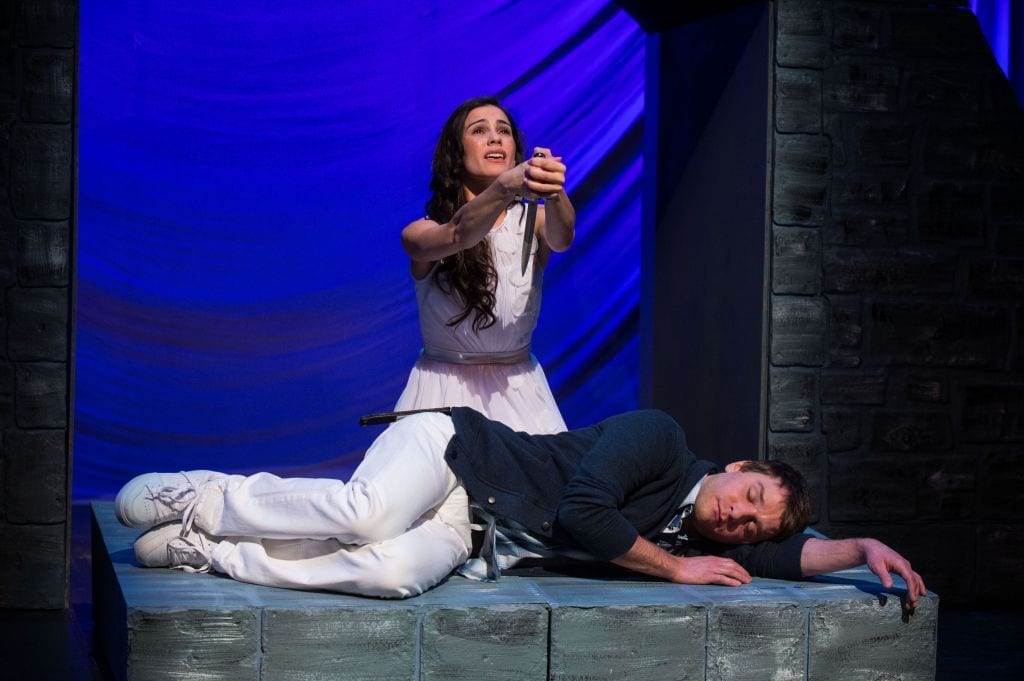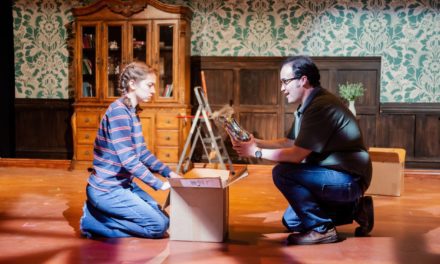SALT LAKE CITY — Each year, the Utah Shakespeare Festival (USF) fills patrons’ lives with wondrous professional theater, both classic and contemporary. They go above and beyond simply producing shows in their home space in Southern Utah, however. In addition to their summer and fall seasons, the festival produces a touring Shakespeare play aimed to educate students in Utah, Arizona, and Nevada. This year’s Shakespeare-in-the-Schools show is the ever-popular Romeo and Juliet, featuring a team of eleven—eight actors, a company manager, a stage manager, and a technical director.

Melisa Pereyra as Juliet and Chris Klopatek as Romeo in the Utah Shakespeare Festival’s 2013 Shakespeare-in-the-Schools production of Romeo and Juliet. (Photo by Karl Hugh. Copyright 2013 Utah Shakespeare Festival.)
Just in case you’re new to literature and/or theater: Romeo Montague sees Juliet Capulet—the daughter of Romeo’s family’s arch rival—and immediately falls for her; Juliet reciprocates. In secret, they are married by a local friar who hopes their union will unite their feuding families. Unfortunately, almost immediately after the wedding a fight in the streets leaves two men dead, one Montague killed by a Capulet and one Capulet killed by Romeo himself. Dilemmas ensue. Rash decisions are made. The story of the century leaves two families both broken and repaired.
The Shakespeare-in-the-Schools production took a minimalistic approach to the play. With a 75-minute cut, the show left out a few characters and moments (such as the Lady Montague and the death of Paris), but I didn’t miss them. The story remained complete and fluid, not to mention as heartwarming (and heartbreaking) as ever.
Juliet was beautifully played by Melisa Pereyra, who was featured in two of the festival’s regular season shows last year. The first time the audience saw Juliet, she was running and bouncing around just like any 13 year-old would. I loved seeing the character’s youth and energy before bounding into the seriousness of the majority of Juliet’s story. Romeo, played by another USF veteran Chris Klopatek, likewise introduced his character youthfully—in his case as a love-sick teen brooding over a crush. Pereyra and Klopatek gave the audience a young, hopeful couple with all the recklessness and enthusiasm of first love.
The entire cast, though, was without a question up to the USF’s usual caliber. The eight actors played around 13 characters, and adeptly so. Three actors hefted the majority of the characters: Zack Powell was Mercutio, Paris, Lord Montague and ensemble characters; Josh Innerst was Tybalt and the Friar; and Elizabeth Telford was Lady Capulet, Samson, Peter, and the Apothecary. All three played their various characters with definite contrast. Telford’s Lady Capulet was a completely different person from her ensemble characters, and I didn’t realize Powell had played both Mercutio and Paris until a significant way into the show. Powell’s Mercutio will probably remain one of my favorite interpretations of that character; I loved his movement style and use of humor. Innerst’s polar opposite characters of Tybalt and the Friar were just that: opposites. He gave the audience a ruthless, proud Tybalt and a humble, sincere Friar.

A scene from the Utah Shakespeare Festival’s 2013 Shakespeare-in-the-Schools production of Romeo and Juliet. (Photo by Karl Hugh. Copyright 2013 Utah Shakespeare Festival.)
Some of my favorite moments in the show included an adorable marriage scene and a really cool juxtaposition of Romeo’s “Banished” monologue with Juliet learning of Tybalt’s murder. Props to director John Maclay for that one.
The show’s setting and time weren’t ever wholly clear, but it never distracted from the story or emotion of the play. The characters wore costumes with touches of modern (hoodies and t-shirts), Asian (the Capulet women’s dresses), and traditional Shakespearean (swords and scabbards). Costume designer Christina Leinicke used color to distinguish the two families: the Montagues in blue and the Capulets in gold. I especially loved the use of white as a neutral. The audience first met Juliet and Romeo in purely white outfits, accentuating both their neutrality and their adolescence, and only saw color added to their ensembles as the influences of their families wore down upon them. Thus, Romeo ended the show in blue—having killed yet another Capulet—and Juliet ended in white, after deciding to abandon her family to run away with Romeo.
My one complaint with the production came with its choice of incidental music. Although not always noticeable, there were moments when the music completely distracted me from scenes. The “Queen Mab” scene was the most jarring, an odd combination of too-loud elevator music and Mercutio’s ever-abstract speech. Many combinations of moments and music simply felt awkward and incompatible.
It’s a challenge to adapt a show to a different space for every performance, but the Shakespeare-in-the-Schools cast and crew did so flawlessly with the help of a straightforward approach to a classic play. Maclay’s direction made for a show that will fit a variety of spaces and audiences. I loved Ben Hohman’s simple, profound scenic design. He hung a delicate white scrim and constructed a bridge that was only ever crossed by the lovers, thus seemingly symbolizing their place as the unifiers of the feuding families.
There were so many things I loved about this production: the simplicity, the earnestness, the accessibility—oh and some top-notch sword fighting. If you get a chance, I would highly recommend this show to any and all. It would be an excellent and easy introduction to Shakespeare for all ages or a charming revisit to a classic story for those of us who already love that good ol’ Bard.

Melisa Pereyra as Juliet and Chris Klopatek as Romeo in the Utah Shakespeare Festival’s 2013 Shakespeare-in-the-Schools production of Romeo and Juliet. (Photo by Karl Hugh. Copyright 2013 Utah Shakespeare Festival.)





